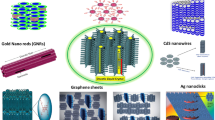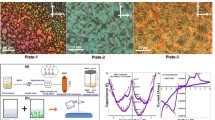Abstract
Well-defined ultra-thin ‘wire’ like cadmium sulfide (CdS) nanostructures have been synthesized by applying simple cost-effective hydrothermal route. The content of nanostructures modifies the nature of surface interaction between two liquid crystal (LC) components as revealed by optical and electrical investigation. Those synthesized nanowires have an average diameter of about 7–10 nm and length up to several micrometers region. A possible mechanism has been proposed and the addition of cataionic surfactant cetyltrimethylammonium bromide (CTAB) into the two mixed-solvents would play an important role on the growth dynamics of the desired product. Those CdS-nanowires dispersing LC was found a remarkable signature on the nucleation and provides a more fundamental approach to modify the crystallographic configuration of host nanostructures. Polarizing optical microscopy (POM) revealed temperature dependent various phases appearence in different textural patterns are the proof the significant influence of CdS nanomaterials complete homogenious dispersion with host LC-matrix. Most observed phenomena are discussed in terms of a new smectic ordering labeled as ‘Smectic X*’, which is sandwiched between the traditional ‘Nematic’ and convectional ‘Smectic C*’ phases. This feature article deals with dielectric relaxations, rotational viscosity, spontaneous polarization in the smectic C phase have been analyzed. A range of remarkable responses of the capacitance with voltage in a Preisach model, fourfold dipolar species in hybrid nanocomposites matrix as well as bi-stable DC switching also offering recent breakthroughs in next generation smart display (LCD) and novel switchable device.







Similar content being viewed by others
References
Y. Xia et al., One-dimensional nanostructures: synthesis, characterization, and applications. Adv. Mater. 15(5), 353–389 (2003)
A.L. Prieto et al., Electrodeposition of ordered Bi2Te3 nanowire arrays. J. Am. Chem. Soc. 123(29), 7160–7161 (2001)
L. Brus, Quantum crystallites and nonlinear optics. Appl. Phys. A 53(6), 465–474 (1991)
H. Weller, Colloidal semiconductor q-particles: chemistry in the transition region between solid state and molecules. Angew. Chem. Int. Ed. 32(1), 41–53 (1993)
K. Pal et al., A facile strategy for the fabrication of uniform CdS nanowires with high yield and its controlled morphological growth with the assistance of PEG in hydrothermal route. Appl. Surf. Sci. 258(1), 163–168 (2011)
K. Pal et al., Synthetic strategy of porous ZnO and CdS nanostructures doped ferroelectric liquid crystal and its optical behavior. J. Mol. Struct. 1035, 76–82 (2013)
K. Pal et al., Dielectric and I–V characteristics of high luminous CdS nanostructures with confined geometrical growth. J. Mol. Struct. 1041, 16–22 (2013)
K. Pal et al., Switching of ferroelectric liquid crystal doped with cetyltrimethylammonium bromide-assisted CdS nanostructures. Nanotechnology 24(12), 125702 (2013)
K. Pal et al., Ultraviolet visible spectroscopy of CdS nano-wires doped ferroelectric liquid crystal. J. Mol. Liq. 164(3), 233–238 (2011)
K. Pal et al., Temperature variation dielectric behavior of TiO2 nanocabbages and doped W-182 (AFLC). J. Lumin. 136, 278–284 (2013)
K. Pal et al., Optical and electrical investigation of ZnO nano-wire array to micro-flower from hierarchical nano-rose structures. J. Nanosci. Nanotechnol. 16(1), 400–409 (2016)
K. Pal et al., Influence of ZnO nanostructures in liquid crystal interfaces for bistable switching applications. Appl. Surf. Sci. 357, 1499–1510 (2015)
K. Pal et al., Design, synthesis and application of hydrogen bonded smectic liquid crystal matrix encapsulated ZnO nanospikes. J. Mater. Chem. C 3(45), 11907–11917 (2015)
G.C. Pimentel, A. McClellan, Hydrogen bonding. Annu. Rev. Phys. Chem. 22(1), 347–385 (1971)
T. Elsaesser, H. Becker, Ultrafast Hydrogen Bonding Dynamics and Proton Transfer Processes in the Condensed Phase, vol. 23 (Springer, New York, 2013)
I. Gitsov, K. Wooley, J. Fréchet, Angew. Chem. Int. Ed. 31, 1200 (1992)
I. Gitsov, K.L. Wooley, C.J. Hawker, P.T. Ivanova, J.M.J. Fréchet, Macromolecules 26, 5621 (1993)
L. Yu, Hydrogen bond-induced ferroelectric liquid crystals. Liq. Cryst. 14(5), 1303–1309 (1993)
K. Pal et al., Switchable, self-assembled CdS nanomaterials embedded in liquid crystal cell for high performance static memory device. Mater. Lett. 169, 37–41 (2016)
S. Miller et al., Modeling ferroelectric capacitor switching with asymmetric nonperiodic input signals and arbitrary initial conditions. J. Appl. Phys. 70(5), 2849–2860 (1991)
S. Miller et al., Device modeling of ferroelectric capacitors. J. Appl. Phys. 68(12), 6463–6471 (1990)
P. Yang et al., Electrical properties of SrBi2Ta2O9 ferroelectric thin films at low temperature. Appl. Phys. Lett. 81(24), 4583–4585 (2002)
Acknowledgements
The author Dr. Kaushik Pal is grateful to his associate colleagues & doctoral research scholars at Wuhan University, China. Especially, Dr. Pal, owe to his sincere thanks to associate colleagues included Bachelor/Masters/Ph.D. students, spectroscopy/electron microscopy operators, as well as entire team of research scholars are also gratefully acknowledged during “Visiting Scientist” associate ship at CNU, South Korea. We are honor to Prof. Mohan’s co-workers of the Liquid Crystals Research Laboratory at Bannari Amman Institute of Technology, Sathyamangalam encouraging liquid crystal preparation. Sincere ‘Thanks’ goes to Dean (Research), at BIHER Chennai (India) for providing Dr. Pal to develope the excellence of research foundation associated with existing Nanotechnology laboratory. The research scholars from Niel University, Egypt are gratefully acknowledged for giving scopes to develop research ideas and scientific innovations. The author Mohamed Abd Elkodous is also grateful to Dean (Research) for giving research friendly scopes at Nile University, Egypt.
Author information
Authors and Affiliations
Corresponding author
Ethics declarations
Conflict of interest
All the authors have declared that, there is no conflict of interest regarding the contribution to the feature article publication.
Rights and permissions
About this article
Cite this article
Pal, K., Elkodous, M.A. & Mohan, M.L.N.M. CdS nanowires encapsulated liquid crystal in-plane switching of LCD device. J Mater Sci: Mater Electron 29, 10301–10310 (2018). https://doi.org/10.1007/s10854-018-9083-3
Received:
Accepted:
Published:
Issue Date:
DOI: https://doi.org/10.1007/s10854-018-9083-3




